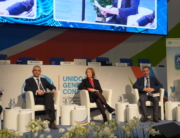This Blogpost from IFIP WG9.5 was written by Silvia Masiero
In April 2020, with three colleagues we co-submitted a panel proposal to an Association for Information Systems (AIS) conference, where panel proposals were subject to single-blind review. Reviewers were hence made aware of the identity of submitting authors, so to assess the “quality of presenters” (sic) in the proposal. As a team of four women experts in our field we interestingly received, from one reviewer, an evaluation of 3/7 on the dimension of “quality of presenters”. What may have possibly led an anonymous reviewer, called to assess a proposal otherwise rated as strong, to give a poor judgement on the “quality” of four women experts?
Gender bias – a systemic, unfair difference in the way men and women are treated in a given domain – is widely studied in terms of employment and careers, with studies highlighting its particular impacts on the IT industry and the digital workforce. Studies of gender bias in academia reveal systemic impacts on dimensions from tenure and hiring decisions to peer review, citation impact and perceptions of publication quality. What is puzzling, as we detail in a recent literature review, is the thin extent to which such a dimension is studied in the Information Systems (IS) field. Out of 7,260 publications in the AIS Basket of 8 journals as of July 2020, only eight make some reference to impacts of gender on IS academic careers.
But why is it important to study gender bias in the IS academia? One could argue that after all, gender bias is widely documented in Science, Technology, Engineering and Mathematics (STEM) disciplines and in the context of digitalisation at large, making it superfluous to study it in IS specifically. While gender bias research is indeed proliferating in STEM fields, my point here is that this does not make it superfluous to conduct such studies in IS. On the other hand, it effectively makes it more urgent, and here are three chief reasons for it to be so.
First, despite limited data on gender bias in IS, anectodal evidence captured in relevant forums, such as the AIS Women’s Network, and by community members is substantial. Such evidence includes the results from a task force, documented in Gupta et al. (2019), that “quietly polled IS faculty on the need to investigate gender disparity and equity in the IS discipline”. As Gupta et al. (2019: 1873-1874) report, colleagues across genders and at all ranks report concerns spanning from the standards to which women are held vs. men to gender-biased tenure decisions, subtle bias, and even episodes of outright sexual harassment and discrimination (Gupta et al., 2019: 1874).
Within such a picture, our panel proposal story can be frustrating, but is by no means surprising. After all, peer review is one of the main dimensions on which gender bias is assessed in the STEM literature, and studies of single-blind vs. double-blind review are a core way to assess it. A study by Budden et al. (2008) analysed acceptance of papers submitted to Behavioral Ecology by female authors after the journal began blind peer review. The result: acceptances for female first-authored papers increased by 7.9% in the four years after the onset of blind review, suggesting that reviewers were less likely to accept manuscripts first-authored by women when they were aware of authors’ gender. If at all, such results put our panel proposal review story in a very clear context.
Second, data from Gupta et al. (2019) reflect the subtle bias displayed by academia as a profession. Handley et al. (2015) find that male academics, particularly those in STEM, rated fake research claiming academia has no gender bias higher than real research showing such a bias. Criado Perez (2019: 96) offers context for such findings, illuminating the known fact of male-default thinking: for example, as a result of the practice of using author initials instead of full names, the gender of academics is often assumed to be male, a default that women editors and reviewers know all too well. As editor, I have ended up building a default response to the all-too-often met “I would like to thank an anonymous reviewer for his insights”, in a context in which women receive less than half as much credit for co-authored papers as men do.
Third, as documented again by Criado Perez (2019), more than 75% of the world’s unpaid care work is done by women. Studies of care work document, amongst other dimensions, gender differences associated to caring responsibilities, with the current working-from-home scenario providing grounds for systemic assessment of impacts. In “Working from Home during the COVID-19 Crisis: A Closer Look at Gender Differences”, Ajjan et al. (2020) study the effects of having to suddenly accommodate working and living in the same place, noting how gender and family responsibilities affected worker reactions. Care burdens are not specific to the pandemic, but have been highlighted and exacerbated during COVID-19, in the digital workforce as well as the academia.
The difference, I submit, between IS and disciplines with a broader membership base is that a tightly-knit community, such as that of AIS, allows for collective reflection and change. The points made here on qualitative evidence of gender bias in the AIS community, gender differences in the academia at large, and impact of care burdens can be reflected on and tackled, an effort that the AIS Women’s Network engages on a regular basis. What I commit to and encourage, as a member of the community, is a continued effort that calls gender bias by its name, puts it in relation with evidence from the academia at large, and involves the community in a conscious and collective effort for change.
Dr Silvia Masiero is an Associate Professor of Information Systems at the Department of Informatics, University of Oslo. Her research operates in the area of information and communication technology for development (ICT4D). Silvia is Secretary of the International Federation for Information Processing IFIP 9.4 Working Group on Implications of Information and Digital Technologies for Development, a member of the AIS, and a member of the Editorial Board at Information Technology for Development.
This blogpost has drawn from research that was presented in the following publications:
Ajjan, H., AbuJarour, S., Fedorowicz, J. and Owens, D. (2020). Working from Home During the COVID-19 Crisis: A Closer Look at Gender Differences. 1st AISWN Workshop on Women, IS and Grand Challenges, 12 December 2020.
Budden, A. E., Tregenza, T., Aarssen, L. W., Koricheva, J., Leimu, R. and Lortie, C. J. (2008). Double-blind review favours increased representation of female authors. Trends in Ecology & Evolution, 23(1), pp. 4-6.
Criado Perez, C. (2019). Invisible women: Exposing data bias in a world designed for men. London: Random House.
Handley, I. M., Brown, E. R., Moss-Racusin, C. A. and Smith, J. L. (2015). Quality of evidence revealing subtle gender biases in science is in the eye of the beholder. Proceedings of the National Academy of Sciences, 112(43), pp. 13201-13206.
Gupta, B., Loiacono, E. T., Dutchak, I. G. and Thatcher, J. B. (2019). A field-based view on gender in the information systems discipline: preliminary evidence and an agenda for change. Journal of the Association for Information Systems, 20(12), pp. 1870-1900.
Masiero, S. and Aaltonen, A. (2020). Gender Bias in Information Systems Research: A Literature Review. 1st AISWN Workshop on Women, IS and Grand Challenges, 12 December 2020.
Image credit: Photo by Dainis Graveris on SexualAlpha






